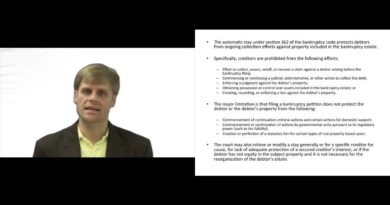What does a Chapter 13 trustee do with a preference?
A Chapter 13 Trustee in Minnesota will identify and investigate any preferential payments that the debtor made within a certain period of time before filing bankruptcy. The trustee can recover the payment if a preference is discovered. This process aims to ensure fairness and equitable distribution of assets among all creditors.
When filing for Chapter 13 bankruptcy in Minnesota, it’s essential to understand the role of the bankruptcy trustee and how they handle your case. A trustee is responsible for managing the financial affairs and assets of those who seek bankruptcy protection. If you are considering filing for bankruptcy, it is important to speak with a Chapter 13 bankruptcy lawyer in Minnesota to understand your situation. Some basics about the trustee’s treatment of preferences are also informative.
Understanding Chapter 13
Chapter 13 bankruptcy allows individuals to reorganize their debts and pay them off through a court-approved repayment plan, typically lasting three to five years. This is different from Chapter 7, which involves the liquidation of assets. You keep your property under Chapter 13 bankruptcy, but the trustee makes sure creditors get what they are owed. The trustee will examine your antecedent debt, or payments you made prior to filing bankruptcy, when it comes time to determine preferences. The trustee will look to see if the payments or transfers unfairly benefited one creditor. If they find that there is a preference they may try to recover the payment and distribute it more equally among your creditors. What exactly is a preference? How does the trustee deal with these situations?
Bankruptcy Code Preferential Payments
One key role of a Chapter 13 Trustee is to identify and address preferential payments. The Bankruptcy Code contains strict guidelines regarding these payments in order to prevent debtors giving preferential treatment certain creditors. What is a Preferential Payment?
A preferred payment in bankruptcy is a payment made by a debtor to their creditor prior to filing for bankruptcy. This gives the creditor more money than they would get under the bankruptcy process. The trustee will look at several factors to determine if a payment is preferred, including the timing, amount and creditor. If a payment is deemed preferential, the trustee can recover the funds and redistribute them fairly to all creditors.
Preference Claims
A trustee can make a preference claim under the Bankruptcy Code if they identify that a payment or transfer meets the criteria of a preferential payment. Preference claims ensure fairness and equality between creditors by preventing one creditor being unfairly disadvantaged over others prior to the bankruptcy filing. The trustee will include the payment in the debtor’s estate, which is then distributed according to Chapter 13 repayment plan. This period can be extended to one year for insiders, such as family members or business associates. Insiders such as family or business associates are exempt from this rule. The Bankruptcy Code has different defenses for regular creditors and insider creditors. Understanding these defenses is critical for creditors who receive payments prior to a bankruptcy filing.
Regular Creditors’ Defenses
Regular creditors, or those who are not closely associated with the debtor, can raise several defenses to a preference claim. The “ordinary course” of business defense is a common defense. Payments that were made in the normal course of business and in accordance with previous dealings between the debtors and creditors may be protected. For instance, if a debtor consistently paid a vendor within 30 days of receiving invoices and continued to do so before filing for bankruptcy, the vendor might argue that the payments fall within the ordinary course of business.
Another defense is the “new value” defense. The payment may not be recoverable if the creditor provided the debtor with new goods or services after receiving the preferential payment. This defense encourages creditors to continue doing business with financially distressed individuals or businesses without fear that payments will be undone.
Insider Creditors’ Defenses
Insider creditors, such as family members or business partners, face greater scrutiny when it comes to preferential payments. Insiders are allowed to have a one-year lookback period, compared to regular creditors’ 90-days. Insider creditors are still able to defend themselves against claims of preference. A defense is to prove that the payment was made in a transaction with no favoritism. In either case, to raise a valid defense, you must provide documentation and evidence to prove the nature of the transaction. The Chapter 13 trustee is often asked how far back he can go to investigate preferential payments. Under the Bankruptcy Code, the trustee has the right to scrutinize transactions that occurred before filing, but the timeframes vary depending on the type of creditor involved.
Ordinary Creditors
For ordinary creditors, the trustee can look back 90 days before the bankruptcy filing. If a debtor made a payment to an ordinary creditor during this period that gave them preferential treatment, the trustee can take action to recover that payment.
Insider Creditors
“Insiders” include family members, business partners, or close associates. Insider creditors can be investigated by the trustee up to one year in advance. The trustee can investigate transactions that may have unfairly benefitted individuals who are closer to the debtor. If the trustee identifies any preferential payments within these timeframes, they will seek to undo those transactions for the benefit of all creditors.
-
Bankruptcy Trustee Undoing Certain Financial Transactions
-
When a Chapter 13 trustee identifies preferential transfers, their next step is to take action to recover or “undo” those transactions. This process is known as avoidance, and it allows the trustee to bring the funds or assets back into the bankruptcy estate so they can be fairly distributed among creditors.How Does the Trustee Undo Preferential Transfers?
-
The trustee typically files a lawsuit in bankruptcy court to avoid the preferential transfer. This legal action, known as an adversary procedure, gives the court authority to order that the transferred funds or assets be returned. The trustee can file an action if, for example, a debtor paid back a personal loan made to a relative three months before filing bankruptcy. Once recovered, the funds would be used to pay off creditors more evenly, ensuring no one creditor benefits at the expense of others.Impacts on the Debtor
-
It’s important to note that preference claims don’t necessarily mean the debtor did something wrong. These rules are meant to promote fairness. In a Chapter 13 bankruptcy, the trustee is given a timeframe to pursue a preferential payment. Understanding the timeline for preference claims is crucial for both creditors and debtors, as it affects the recovery and distribution assets in the bankruptcy estate. If the trustee discovers a preferential payment in the course of the case, he or she has two years to file suit in bankruptcy court. The trustee must adhere to the Bankruptcy Code’s lookback periods. As previously mentioned, regular creditors have a 90-day period of lookback, while insiders have a one-year period. A trustee can take action quickly if they identify a possible preferential payment in the early stages of the bankruptcy case. How to protect a family member or friend from a preference avoidance action
How can you protect a family member or friend from a preference avoidance action?
One of the most worrying aspects of preferential claims for debtors are the potential impacts on family members or close friends who received payments prior to the bankruptcy filing.
If you repaid an unsecured personal loan to a close relative or friend before filing for Chapter 13 bankruptcy, the trustee could pursue a preference claim to recover these funds. There are ways to keep your loved ones out of the bankruptcy process. It’s important that payments made to insiders be documented and resemble the terms of an ordinary, arms-length loan. If you agree to repay a personal loan to a family member under terms that are similar to those you would receive from a bank (i.e., regular monthly payments with interest), the trustee may be less likely to view the payment as preferential.
Additionally, spreading out payments to insiders over a longer period of time may help avoid triggering the preference rules. It may be better to spread out payments for a family loan over time rather than paying it in one lump sum just before filing bankruptcy. This can reduce the risk of the payment being deemed preferential.
A Chapter 13 Attorney Can Assist with Your Bankruptcy Filing in MN
By understanding the defenses available to creditors, the timelines for preference actions, and the exceptions to the preference rules, both debtors and creditors can better protect themselves during a Chapter 13 bankruptcy case in Minnesota. For debtors concerned about preferential payments, consulting with a local bankruptcy attorney can help ensure that financial transactions are handled in accordance with the law, while minimizing the impact on family members, friends, and creditors.
Don’t let bankruptcy overwhelm you. LifeBack Law can help you find ways to eliminate debt and rebuild a better life. Schedule a free consultation today by visiting us online or calling 320-252-0330.
FAQs
Who gets paid first in cases of bankruptcy?
In Chapter 13 bankruptcy, secured creditors are generally paid first, followed by priority unsecured creditors. General unsecured creditors may receive a portion of their debts through a Chapter 13 repayment plan.
What is the lookback period for preferential transfers?
The lookback period for preferential transfers varies depending on the relationship between the debtor and the creditor. Insiders have a one-year lookback period. Non-insiders have 90 days. The payment may not be considered preferential if it was made in the ordinary course of business between the debtor and creditor. The payment is considered preferential if it gives the creditor an advantage over other creditors.
What are the defenses to a preference claim?
There are several defenses to a preference claim, including:
Subsequent new value:
If the creditor provides new value to the debtor after receiving the preferential payment, it may reduce or eliminate the preference claim.
Ordinary course of business:
If the payment was made in the ordinary course of business between the debtor and creditor, it may not be considered preferential.
Contemporaneous exchange:
If the payment was made in exchange for contemporaneous new value, it may not be preferential.
How many days the US trustee looks back to see if a payment is a preference payment to an insider?








